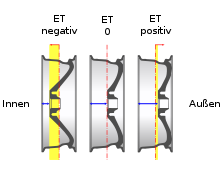Offset
The offset (also abbreviated ET) - with some wheel manufacturers also "IS" or " Offset " - of a vehicle wheel is the distance between the center of the rim (measured between the rim flanges) and the inner contact surface of the wheel flange. The dimension is given in millimeters and can have both positive and negative values. Other dimensions of wheels and rims are given in inches . The corresponding support surface of the chassis , the hub flange , can also accommodate the brake drum or the brake disc .
General
If the offset is 0, the vertical center plane of the rim and the contact surface on the vehicle are aligned. The track width of a vehicle can be changed by modifying the offset . With a positive offset, the contact surface is shifted towards the outside in relation to the center of the rim and the entire wheel with tire "sits" further inside in the wheel house. The greater offset therefore leads to the track being reduced. A reduction in the offset for the same rim width, on the other hand, leads to a shift of the wheel outwards and thus to a wider track.
On steered axles, a changed offset leads to a changed steering geometry, which has a particular impact on the road safety of the vehicle. If the wheel offset differs from the vehicle manufacturer's specifications, the use of the wheels is prohibited according to the Road Traffic Licensing Regulations (StVZO). Changes to the wheel or axle geometry, such as those that occur when using wheels with a different than the permitted offset, therefore lead to the expiry of the operating license in Germany .
Calculation of the offset
For rims whose offset is not known, the ET can be determined by measuring and calculating.
To do this, the rim is first placed on a flat surface with the outside facing down. A fitted tire can falsify the result and must therefore be removed.
Then the distance between the contact surface of the wheel flange and the two outer edges of the rim is measured and the difference between the two measured values is calculated. The halved difference corresponds to the offset. If the distance between the inner edge of the rim and the contact surface is greater, the offset is positive, otherwise negative.
In vehicles with double tires, the offset is slightly larger than half the tire width, so that two identical wheels can be mounted on top of each other. The outer wheel is installed upside down, which makes the offset negative.
literature
- Günter Leister: Vehicle tires and chassis development . Strategy, methods, tools, 1st edition, Vieweg + Teubner, Wiesbaden 2009. ISBN 978-3-8348-0671-0 .
- Hermann Brähler, Jochen Graefenstein, Wolfgang Appel, Ulrich Dahlhaus, Thomas Esch: Commercial vehicle technology . Basics, systems, components, 2nd revised edition, Springer Fachmedien, Wiesbaden 2002, ISBN 978-3-663-05762-8 . 8th edition 2016, ISBN 978-3658095369 .
See also
Web links
- The offset (accessed on November 23, 2015)
- Information on the offset (accessed on November 23, 2015)
- Injection depth what is that, calculation bases (accessed on November 23, 2015)

